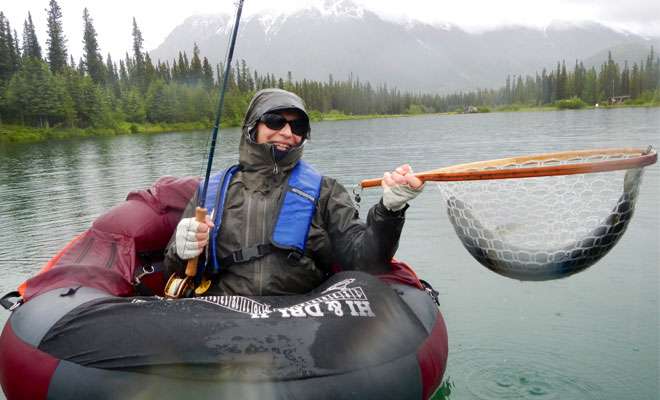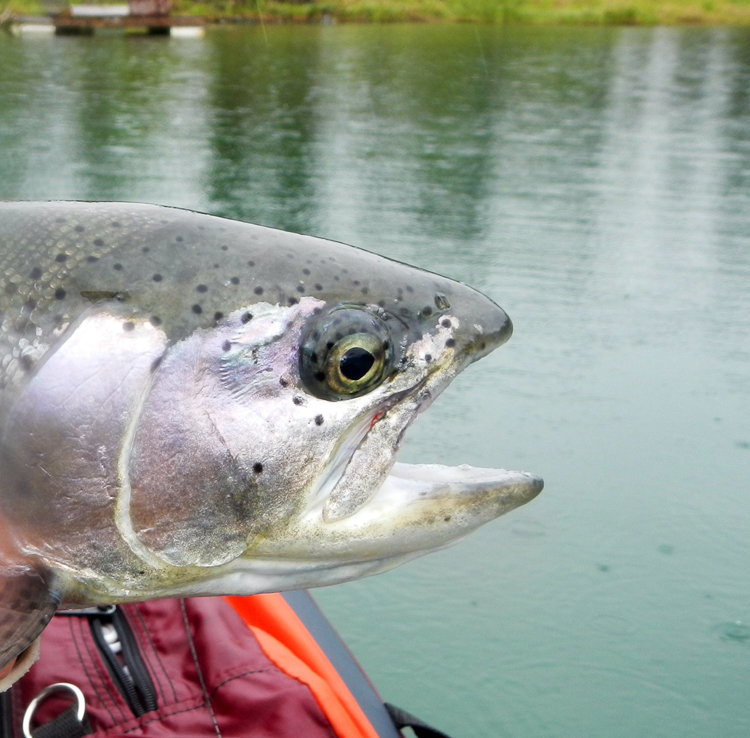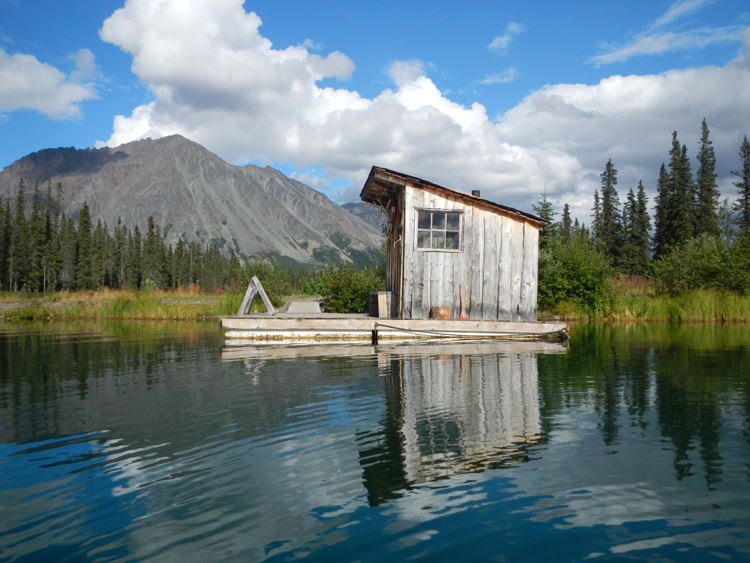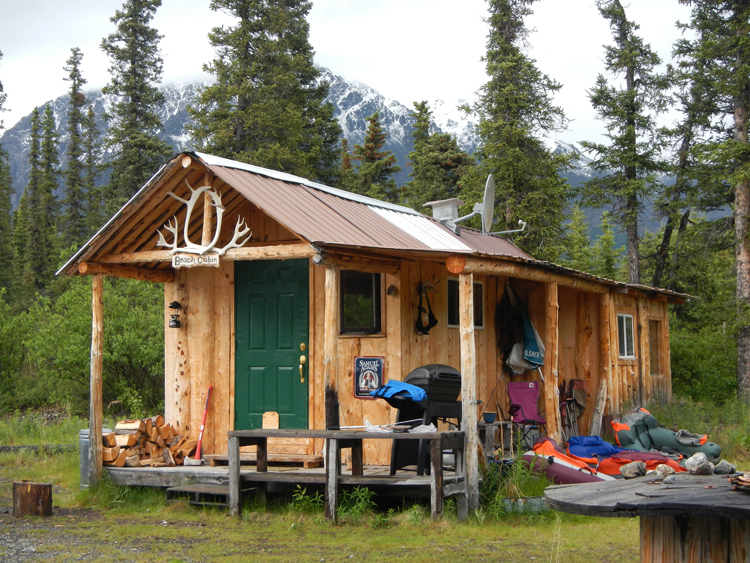I know what you are thinking— that there are no rainbows in Denali because it’s just too cold for them to survive there. Well, that’s what I thought too, until I encountered the rainbow king of Denali. Not only do his Denali rainbows survive, but some of them have grown to 30-inch behemoths.
A “Pay To Fish” Kingdom!
Story & Photos by Pudge Kleinkauf
Nope, they’re not inside a heated building or a heated tank as you might have guessed. Instead, they are swimming around being pampered in a very special private lake system right outside his house in one of the most beautiful settings one could ask for. Believe it or not, it’s just 20 miles south of the Denali National Park entrance.
Kirk Martakis, the sovereign of this realm, invited me to come and fish, and I had to go check it out. Kirk is an amazing man who has turned a property that he originally purchased as a base for his hunting business into an incredible fishery and resort. Kirk left New York for Alaska and a life in the outdoors in 1979. After a stint as a rafting and hunting guide he became the owner of a hunting guide service based in Cantwell, called Denali Wilderness Outfitters.
A 160-acre homestead with three lakes became the 50-acre kingdom with two lakes that Kirk now owns, as neighbors bought some parcels from his original purchase. He proceeded to develop the location with an airstrip, sawmill, horse corrals, a still flourishing garden and his eco-friendly home, which he named Wolf Point Ranch. He led big-game hunters into Alaska’s backcountry by both horse and plane until the time came that his family needed him at home. Then he sold the guide service and went into real estate. A very complex background for a king, it seems to me.
Because he was then “semi-retired,” he had time to volunteer at his son’s small school in Cantwell, to host potlucks and fishing get-togethers for neighbors at his lake, and to build a few comfortable lakeside cabins for tourists on their way to Denali National Park, an operation that his son, Tanner, now oversees. He also devoted his time to making the entire compound energy efficient with solar panels, wind generators and other eco-friendly devices. His longtime garden is a riot of green vegetables, gorgeous lettuce of several types, snap-pea vines and even potatoes, which are incredibly sweet. He sells produce to the locals when he, Tanner and the guides just can’t eat it all. We feasted from that garden every evening and made heavenly french-fries in the cabin’s oven.

The lake, now known as Chavey Lake, already had an excellent number of native Arctic grayling when he bought it 18 years ago, but the fishing was quite poor. Soon, however, he began to wonder if rainbow trout would survive if he planted them in the lakes. So, over a four-year period, 18 years ago, the Alaska Department of Fish & Game stocked the lake with 6- to 8-inch trout. Thanks to habitat enhancement, a feeding program and catch-and-release practices, both the rainbows and the native grayling are now flourishing. The middle lake was not deemed suitable for stocking at the time, and the two different lake levels kept the fish enclosed.
Fish pellets supplement the trout’s diet during the summer months. It’s great fun to watch Tanner, who has his own house on the property, row around the lake tossing handfuls of pellets out either side of a rowboat. Absolute pandemonium reins throughout the entire perimeter of the lake for a time as a result. The strong, robust fish are also due to the lake’s healthy vegetation, some great bug life and the active springs and groundwater trickling through the lake’s surroundings nearly year-round, which keeps the water oxygenated.
The “pay-to-fish” concept at the lakes emerged from Kirk permitting people who rented his cabins to fish in the lake. He added several small docks to provide them a casting platform, and from there he expanded to offer day-fishing to visitors staying in the many hotels and lodges that have grown up around the entrance to the national park, as well as to anglers trekking from other points around Alaska and beyond.
Kirk has several different fishing packages that include pickup and return back to a tourist’s hotel as well as gear and equipment. He encourages fishing with a fly rod, and his guides are always ready to instruct clients who have not yet taken up the sport. Now guests from Denali lodges and his cabins can catch fish between 8- and 30-inches in size, as well as Arctic grayling up to 20 inches long. Kirk limits the number of anglers on the lakes to maintain an uncrowded experience. Everyone who fishes the lake must do so with one of the guides and must also follow the strict catch-and-release policy that is always in effect. As a result, fish mortality is as close to zero as possible.
We’ve been at the lake several times now and have great stories to tell of each and every one of the visits. The first four-day trip we enjoyed was in late July, and the fish had been getting themselves caught all summer. Yet, we found hardly any with signs of hook damage in their mouth.
The two women with me had never fly-fished before, nor had they ever been in a float tube. They were absolutely overcome with excitement as we geared-up, had a short casting practice and a lesson about paddling backwards. It wasn’t 10 minutes later that Linda was screaming for help as her rod bent double, the fish swimming away with her in tow. “I can’t believe it,” she kept saying as I helped her keep her line tight, turn her body and tube so that she was facing the fish, and be patient as it did its thing. We finally landed it and it measured at 32 inches. You couldn’t have asked for a more beautiful fish.

On that same trip Stephanie hooked, played and landed an equally large fish that was quite a bit darker than Linda’s. Both of them kept catching all day and quite a few of their fish were in the 27- to 28-inch category. They also lucked into a grayling feeding frenzy close to the grass on one bank; it didn’t matter what fly we fed them, they took it, no problem. By the time these two were done, they could count themselves as accomplished fly anglers.
Our first trip the following year took place in late June in hopes of hooking some of the large fish on dry flies, but alas, it was raining and colder than heck, with new snow on the mountains above the lake and super-cold water. The fish were very active (just not on dry flies) and it was less than half an hour before Eileen announced a large fish on her olive Bunny Leech. She knew what to do with it and played it with mastery. We had to try all four of my nets before we found one that would hold it for measuring and picture taking.
After that Pam got going as well. She had fished before, yet never for such large fish, but with just a bit of coaching she, too, was doing well. That was until a really big fish came out to play. Round and round she went in the tube, trying to keep her body pointed toward the fish and worrying that the line was going to wrap around her leg. I finally got her paddling backwards to help keep her distance from the fish, and at last it showed signs of tiring. Just as Kirk came to video the landing, the fish freed himself. It had snapped 10-pound-test leader.
The next day Sandy hooked up with a huge fish on a small black leech. It’s been a long time since I’ve seen such an active fish. Leap after leap and run after run didn’t seem to tire it a bit. Seven attempts to get him in the net failed, and I was getting worried about stressing him too much. He finally gave up, and we got some pictures. Then he forced himself out of her hand as though the battle had never occurred.
Clearly, the fishing in Chavey Lake is truly amazing. Huge, torpedo-sized rainbows often swim silently along with us as we paddle the float tubes around the lake, but they don’t always take the flies we offer. We can’t figure out whether they think that we are part of the feeding program, or if they are just in love with our fins. In twos and threes and even fours, they form small pods of feeding fish, and unless the water is clouded by rain, we can see them opening their huge mouths to engulf hatching nymphs or a tiny Arctic grayling or trout. Localized feeding spots in specific areas of the lake are common from time to time, and it is easy to see fish accelerating quickly toward such places as these events occur.
Large Arctic grayling typically join in the feeding frenzies and provide us with other interested fish. It is surprising to see them attack and grab the large streamers that we are using for the trout. At the same time, we can usually expect lots of action on #8 or #10 olive Woolly Buggers or Beadhead Lake Leeches. It is very apparent that lots of different-sized specimens now occupy the lake.
This year we turned them all on with #6 Czech beadhead nymphs. It had been raining hard and blowing even harder all morning, keeping the fish pretty close-mouthed, and we’d finally opted for a rest and a hot bowl of soup. Everyone was reluctant to get back into the tubes, so we took a hike on the newly finished trail around the lake and fished from the bank on both Chavey and the middle lake. Small fish just couldn’t get enough of our nymphs and lake leeches, but all the large fish did was swim by, take a look and continue on their way. So, when the rain stopped and the wind calmed down somewhat, we were all ready for the tubes again.
With a few more clothes, warm and dry gloves and another hat or two, we ventured out onto the lake a second time. We hoped to stay out of the wind by setting up on one section of the lake that was somewhat protected. We’d changed tactics now and were using 8-pound tippet with the big Czech nymphs; the party got started almost right away. We couldn’t keep the 12- to 16-inch fish off, and it was fish after fish, after fish, for all of us. Then, suddenly, one of the big boys decided he wanted in on the party and zooming in between two of the tubes, he absolutely devoured the nymph with a hit so hard he almost pulled the rod into the water.
As the large rainbows always do on the lakes, he headed straight for the bottom and stayed there, keeping the 8-weight rod bent so deeply I was afraid he was going to break it. Time after time he rocketed away with enough strength to pull the tube behind him, and then he dove again. Three or four of these scenarios occurred before he showed any sign of being ready to come in, but we had the net ready for him when he did. As we took the hook out he managed to slide out of the net so we never got a length and girth on him, but Kirk, who was watching it all, pegged him at about 30 inches.
Two more of the big fish took nymphs in the same manner but were able to get away during the fight, as they managed to feel a bit of slack, just enough for the fly to dislodge. By then it was raining really hard again, and we decided to quit for the day. Tanner had laid a fire for us in the cabin’s woodstove and we were more than ready to sit with a glass of wine while the spaghetti sauce warmed.
A few years ago, Kirk began noticing that a number of his fish were attempting to spawn in a small drainage ditch that connects two of the three lakes on the property. Approximately 5% of hatchery fish (at least in earlier days) failed to succumb to the chemicals in the tanks that render them unable to reproduce. Such fish are known as triploids, and they are still able to spawn. Kirk’s efforts turned to transforming this ditch into a bona-fide spawning creek, and now, both rainbows and grayling spawn there and, fish of all sizes reside in his lake. The other two lakes on his property are also beginning to benefit from the results of the spawning. After 18 years of strictly catch-and-release, there are now enough rainbows in Chavey Lake that Kirk is planning to permit about 70 rainbows in the 12- to 16-inch category (the 3-year-olds) to be harvested this upcoming season.
During a long conversation with Kirk one day I asked him to project his future at this unique place. He is hoping and planning to enlist assistance from various fisheries professionals to help him conduct research on his fish and his lake. Like so many others, this fishery is also experiencing increased algae blooms, and Kirk is enlisting the help of the University of Alaska Fisheries Department and solar-powered large scale filter/aerator pumps during hot summer days to deal with it.
He has a dream that someday he might be able to help others develop places like Chavey to give wider opportunities for people to enjoy lake fishing. He is also building a tackle and fly shop and a few more cabins lakeside. He is beginning to act further on his passion for sustainable living by starting a “Going Green Tour” for Denali Park visitors, demonstrating how wonderful living a low fossil fuel life can be. In conjunction with that effort, he is also helping people and businesses in the area to find and install alternative energy systems. The solar panels around the lake and around his home give evidence to his efforts, as does that amazing garden.
In his spare time, Kirk ultimately hopes to develop a small, peaceful subdivision based on the fish, fishing, the lakes and the river out back into a planned angler’s paradise called Chavey Lakes Community. He plans lots of green space, full access to the lakes and river, controlled access to fishing and rules to maintain the quiet Alaska atmosphere he so enjoys.
Float-tubing these lakes is a special privilege that Kirk allows us and we protect his fish with a similar zeal and care. His dream of proving that rainbow trout could thrive in the right habitat, even in locations in very cold climates, has resulted in a trophy-class fishery. Thisis Alaska’s first pay-to-fish endeavor where the fish clearly come first. A perfect example of the benefits of strict and high-level catch-and-release, Kirk has a fishery that has maximized the quantity and quality of the angling experience. The success of this private fishery has created food for thought within the fishing public and among fisheries managers alike.
###
Cecilia “Pudge” Kleinkauf has owned and operated Women’s Flyfishing, a Trout Unlimited-endorsed business, for 28 of the 44 years she has lived and fished in Alaska. She teaches women how to fish with a fly rod and guides women and couples to various locations in Alaska throughout the summer. Besides being a contributing editor for Fish Alaska magazine, Pudge is the author of four books, the most recent of which is Pacific Salmon Flies: New Ties & Old Standbys. She can be reached at www.womensflyfishing.net.



